Spring 2018
The Lion Catcher
Biologist Eric York lived to help wild carnivores, but he didn’t get a chance to finish his life’s work.
It was 4 a.m. on a frosty fall morning in 2007.
Darkness and crisp ice blanketed the Grand Canyon National Park road as I headed out of the park toward Flagstaff. A large tan animal stepped onto the pavement, and I skidded to a halt. My eyes slid from its small head down the lithe body to the tail, which seemed to go on forever as it ambled across the road. It didn’t trouble to give me a glance. This was my first – and only – mountain lion sighting at the Grand Canyon, where I worked as an interpretive park ranger. I was surprised the cat wasn’t wearing a radio collar, because wildlife biologist Eric York had been fitting South Rim lions with tracking collars for the past four years.
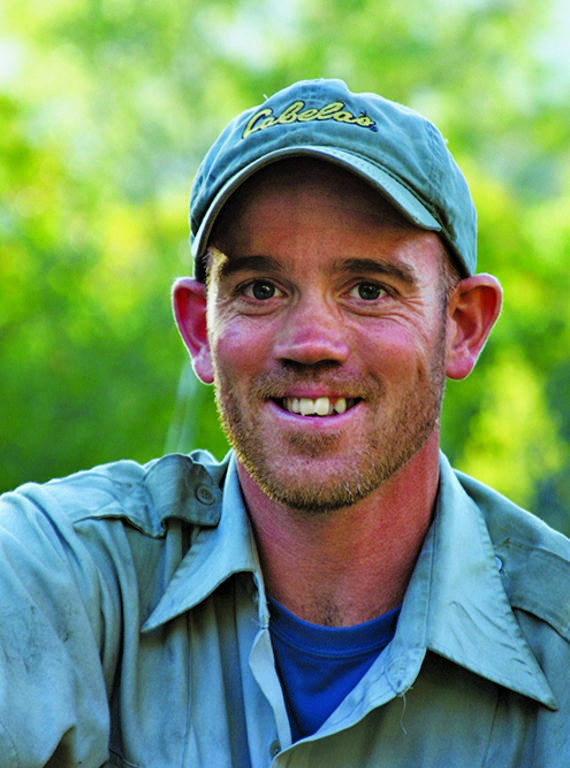
Eric York in 2002.
NPSFor a long time, many doubted the existence of mountain lions at the Grand Canyon. Elaine Leslie, a park wildlife biologist, was determined not only to prove their presence, but to track their movements. She wanted to learn more about the role lions play in the canyon’s ecosystem and how these predators affect deer and elk herds. To study the whereabouts of mountain lions, biologists first need to capture them and place tracking collars on them, though capturing lions is no simple task. Trappers usually capture the animals (also known as pumas, cougars or panthers) by chasing them with hounds until they are cornered in trees, but Leslie wanted to find a biologist who could capture mountain lions without having to hunt them down. “I knew some hunters and trappers, but I was looking for somebody a little different who respected what a park as a protected area was all about,” she said. One of her colleagues recommended York, who was working as a wildlife biologist at Santa Monica Mountains National Recreation Area. In his career, York had trapped carnivores of all sizes — including mountain lions.
York began his field work in Grand Canyon in 2003, and before long he had captured several South Rim cats and fitted them with radio collars. The collars produced unexpected information: From the data York and his colleagues collected, they learned, for example, that lions swam the Colorado River and that they journeyed 150 miles to Flagstaff and back again. One by one, data points created a picture of the species’ abundance, distribution and role in the Colorado Plateau ecosystem.
By the time I arrived at Grand Canyon in 2005, York’s project had gained some fame within the park. Inspired by his findings, I put together a program for visitors on Grand Canyon mountain lions during the summer of 2007. York was eager to help, providing photos and hair snares used to snag lion fur for DNA testing. He’d pop into my office early in the morning after checking his lion traps, shirt tucked into a dusty pair of Carhartts and a ball cap perpetually locked to his head. Our interactions were brief because he was always on the move, restless in the office and anxious to get back into the field as quickly as possible.
Shortly after my puma sighting in October, a collar indicated that one of the mountain lions was no longer moving, suggesting the animal had died. Always happy to share hands-on experiences, York invited me to retrieve the dead cat with him. I was busy at the visitor center, so I declined the invitation, and he went alone. York carried the lion’s 90-pound body to his vehicle and drove home to conduct a necropsy and determine the cause of death. “He had this innate curiosity. He wanted to discover how things worked,” Leslie said. “It wasn’t good enough to find a dead lion; he had to find out why it died.” York had performed many post-mortem examinations during his career, and this lion seemed no different from the other dead animals he had examined.
Grand Canyon did not have a suitable laboratory, so York took the mountain lion to his garage. Shortly after working on the open carcass, he started to experience flu-like symptoms. He visited the Grand Canyon clinic and was sent home to rest and recover. A few days later, his co-workers found him at his home, dead from respiratory failure. York had unknowingly inhaled airborne Yersinia pestis, bacteria relatively uncommon in lions and even more so in humans. The bacteria had proliferated in his body, and he had died of the pneumonic plague. He was 37 years old.
For weeks, the park was in a state of shock. Everyone who had had contact with York was examined at the clinic and treated with antibiotics. The Centers for Disease Control and Prevention held trainings on the plague for staff. Like many, I felt the aching loss of a colleague, but I also struggled with the knowledge that I could have helped carry the cat, sat beside York during the necropsy, inhaled the same bacteria and shared his fate. Ten years later, I’m still trying to make sense of it all.
York grew up on his family’s farm in rural Massachusetts, caring for livestock and gardens, harvesting hay, and riding horses. “He loved to spend time in the woods building forts with his friends or just walking for hours,” his older sister, Andrea York Stoltzfus, wrote to me. “He liked to hunt and hike and watch for tracks and signs of wildlife.” His childhood rambles and experience with domestic animals ignited an interest in studying wildlife at the University of Maine, where he learned how to trap and track elusive species such as martens. Later, he pursued a graduate degree in wildlife conservation at the University of Massachusetts, where he collared and tracked scores of fishers and developed skills that set him apart in a competitive field.
Ray Sauvajot, then the chief of resource management at California’s Santa Monica Mountains National Recreation Area, was developing a project to study how urbanization affected carnivores, and he needed a skilled trapper. After he heard about York from the young biologist’s graduate school advisor, Sauvajot flew to the University of Massachusetts to recruit him. York, who had never been west of the Mississippi, soon found himself chasing carnivores around Los Angeles.
Dashing up and down the area’s steep terrain, York set traps to capture bobcats, coyotes, badgers and gray foxes. “Eric was like a mountain man brought forward in time, where the skills that he acquired on the frontier were applied to 21st-century wildlife conservation,” Sauvajot said.
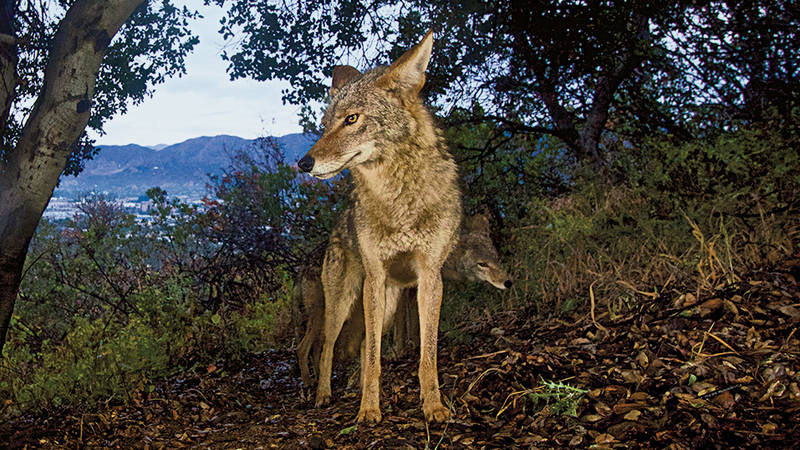
A coyote captured by a motion-triggered camera in Griffith Park in the Santa Monica Mountains.
NPSOver several years, York helped catch almost 200 animals and fit most of them with radio collars. He and his colleagues followed their movements through the hills, gathered data on their genetic diversity and their response to encroaching human development, and learned how obstacles such as Highway 101 isolated vulnerable populations. After his hundredth coyote capture, York got a coyote track tattoo, a sort of tradition he had started with fishers in New England.
York’s work obsession and fierce independence did not prevent him from making meaningful connections with his friends and colleagues. He was a cheerful companion in the field, and he liked to celebrate difficult carnivore captures by joining his colleagues for beers or tequila shots. He fashioned lamps and bottle-openers out of deer antlers for his co-workers in his spare time and returned from trips back home with boxes of lobsters for his California colleagues. Sometimes he’d drive hundreds of miles to attend Red Sox games and hang out with friends. One of his last tattoos was a compass, with the needle pointing northeast. Even though he loved his work out West, he never stopped missing his family and his beloved New England.
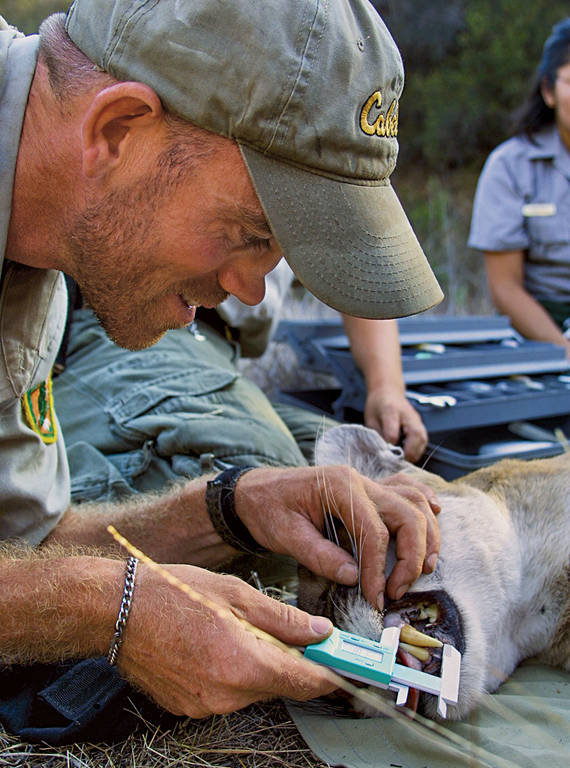
York measures the canines of the first mountain lion captured by the Santa Monica Mountains park staff.
NPSSix years into the urban carnivore study, Sauvajot kicked off research on mountain lions. Just like pumas in the Grand Canyon, mountain lions in the Santa Monica Mountains were so elusive that many locals thought they didn’t exist.
Biologists trapping mountain lions must first search for tracks, scat and other signs of the cat’s presence in order to place their trap in the path of the animal. After he settled on his location, York used padded cable restraints — loops that require the animal to step into an area the size of a softball. Once a puma activated the trap, the cable would tighten to a circumference slightly larger than the lion’s wrist and hold the animal safely until York arrived. He would then dart the captured cat with a tranquilizer, take blood samples, weigh the animal and determine its sex and approximate age. Before releasing a mountain lion, York equipped it with a collar whose radio and GPS signals would allow him to follow the animal’s movements in the wild.
I asked Leslie why York was so good at what he did. “Patience. That’s the key,” she said. “He didn’t need to run dogs. He knew the science. To be honest, he thought like a lion.” York knew how and where the lions moved, giving him exceptional insight into where to place his traps.
That knowledge didn’t come easily to York. He had to earn it. His field days were grueling, starting well before sunrise. “He would fight swarms of biting insects, belly crawl through the brush or scale a waterfall to lay out his traps. He was a workhorse in the field,” said Bert Frost, who collaborated with York at the University of Maine and is now the Alaska regional director for the National Park Service. “He was a frickin’ animal. He’d go plowing through the forest like a bull moose in heat and good luck trying to keep up with him!” York was a workaholic, putting in long days and working on weekends and holidays. “At the end of a long hard day, he’d come back and be tinkering with equipment until it was time to go to bed, taking apart radio collars or rigging up transmitters with different batteries,” said wildlife biologist Jeff Sikich, who worked alongside York in several of his jobs.
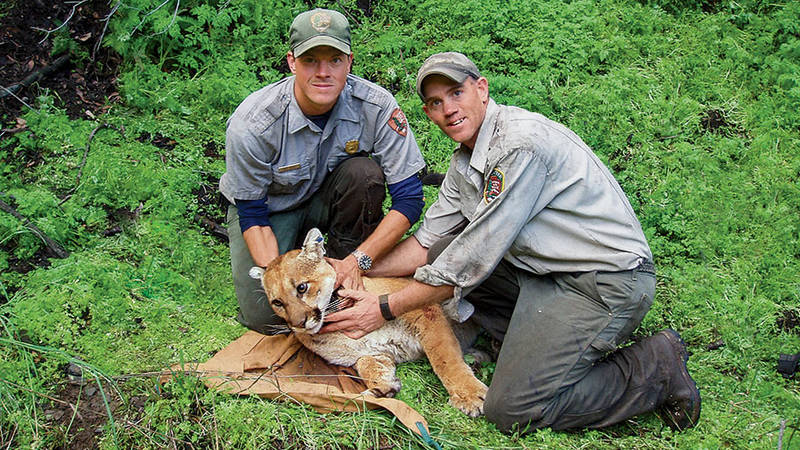
Eric York (right) with Jeff Sikich, a biologist at Santa Monica Mountains National Recreation Area. Staff there recruited York when they were looking for a skilled trapper.
NPSThings did not always go as planned. One day, York was setting cable restraints in the Santa Monica Mountains by himself, a task he had performed thousands of times before. Somehow he failed to set the safety, and the trap triggered, cutting him from his lip through his nose. A bloody York hiked out and headed to a clinic for stitches. Sikich, who was York’s housemate at the time, still uses this story to train new biologists on how to set a trap safely.
Eventually, York’s dedication paid off. In 2002, one of his remote cameras snapped his first lion photo. Later that year, York trapped and collared his first mountain lion.
York thrived on the excitement of tracking and catching lions, but he never lost sight of the point of his work and how it helped park managers understand and ultimately protect these magnificent creatures. “York had a love for the animals, not just the catching,” Seth Riley, Santa Monica Mountains’ chief wildlife ecologist, told me. “We’d be slogging along saying, ‘FTP: for the pumas.’ It means we’re doing it for them, so we gotta keep going.” York would be out at dawn and dusk, checking his traps to ensure an animal did not stay in a trap longer than necessary. Having unintentionally secured minor celebrity status as the guy who tracked mountain lions in Malibu, he sometimes mingled with the Hollywood elites and hunting groups to make the case for lion conservation. “That wasn’t necessarily supposed to be a big part of his job, but he made it that way,” Sauvajot said. “He wanted that.”
Years later, Sauvajot still vividly remembers getting the phone call about York’s death. “I was just shocked,” Sauvajot said quietly. “It was the cruelest irony that a tiny microorganism would be the ultimate fatal blow to somebody who worked with some of the biggest and fiercest creatures in the world.”
A memorial service for York was held at a Grand Canyon viewpoint at sunset. I remember Mary Bomar, then the director of the Park Service, speaking, but I was too numb to take in what she said.
Almost immediately, agencies and organizations across the nation created new protocols and policies to ensure other biologists wouldn’t suffer York’s fate. In York’s memory, Grand Canyon staff raised funds to support park wildlife programs and teach visitors about local wildlife and endangered species. A scholarship in his name now helps biology graduate students pursue careers in wild cat conservation.
York’s work continues to benefit the animals he dedicated his life to protecting. One study co-authored by York found that a major source of urban carnivore mortality was rodenticide poisoning. Regulations for rodenticide changed at local and federal levels as a result of those findings. Today, the lion study York launched is helping the Park Service and conservation partners justify a wildlife overpass above Highway 101. This overpass would not only help prevent lions from being hit by cars — 18 cats have been killed in collisions since York began the lion project — but connect isolated populations and strengthen their genetic health. (Mountain lions living in the Santa Monica Mountains and those in the nearby Santa Ana Mountains are so isolated that they have the least genetic diversity of any puma populations except for the Florida panther.)

National Parks
You can read this and other stories about history, nature, culture, art, conservation, travel, science and more in National Parks magazine. Your tax-deductible membership donation of $25 or more entitles…
See more ›The data points York collected at Grand Canyon help park managers understand when and where lions cross busy roads, which allows them to regulate traffic to protect the cats. Shortly after York’s death, the park hired wildlife biologist Brandon Holton to carry on the lion program. Holton expanded the study and continued trapping and collaring lions. He is currently working on publishing the research that York began.
Ten years later, York’s dedication is still rubbing off on his colleagues. “Even now, when it’s been a long day, I’ve been hiking hours on end and there’s one more thing I can do, I’ll think, ‘What would Eric do?’ And yup, he’d go do it,” Sikich said.
“Eric’s ashes were spread around the country in places he truly loved,” his sister wrote. Several friends and co-workers spread some of his ashes in the Grand Canyon, and some were buried in a country cemetery visible from his family’s Massachusetts farm. His tombstone is carved with the head of a mountain lion keeping watch. Below it are the words of John Muir: “In every walk with nature, one receives far more than he seeks.”
About the author
-
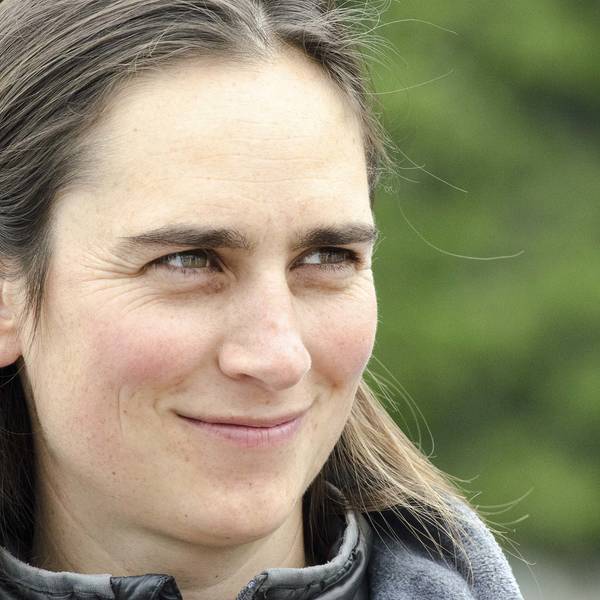 Emily Mount Contributor
Emily Mount ContributorEmily Mount worked as a national park ranger at 10 national parks across the West. Today she is a naturalist and photography instructor for Lindblad Expeditions/National Geographic and a freelance environmental writer and photographer.


